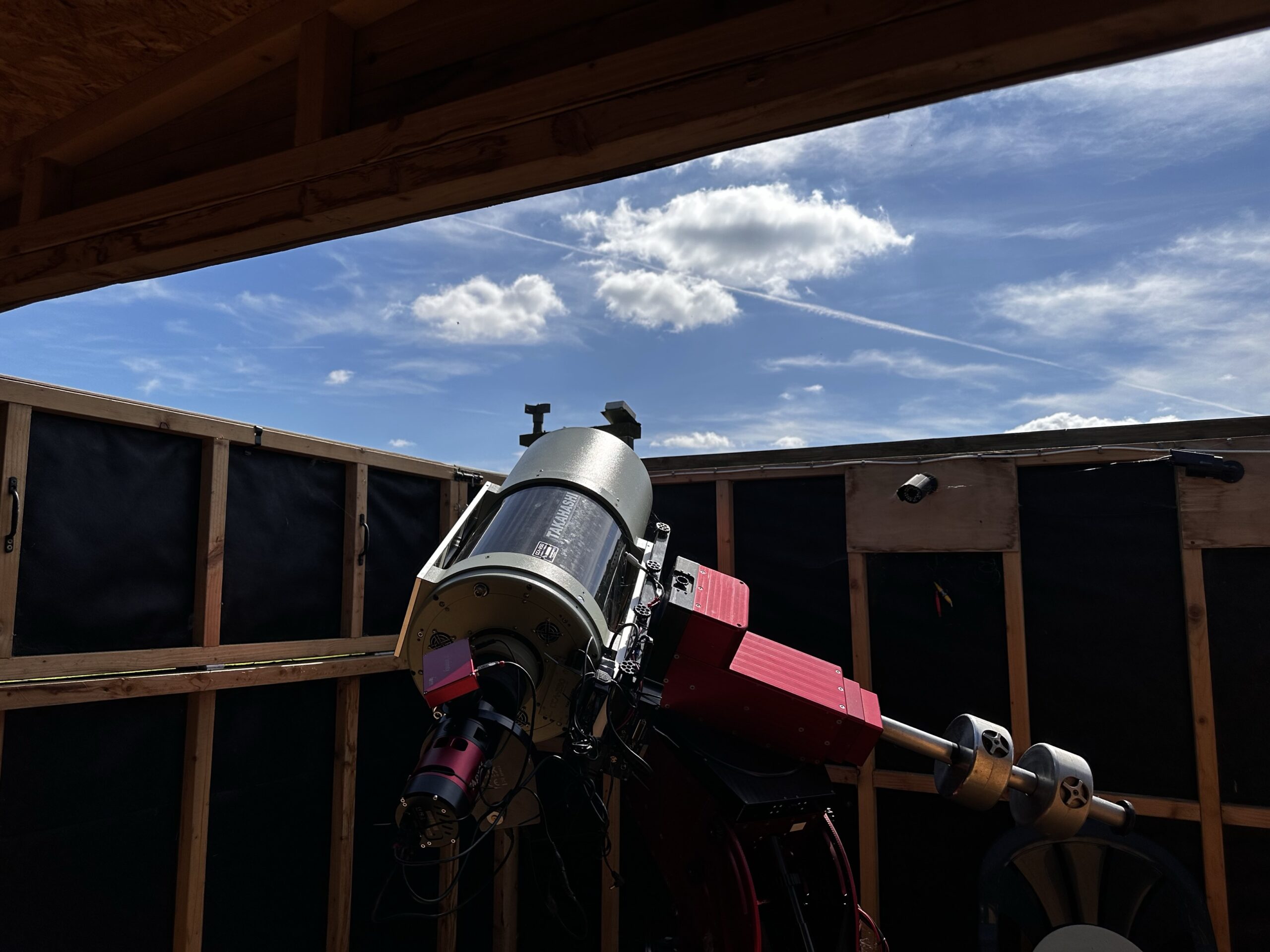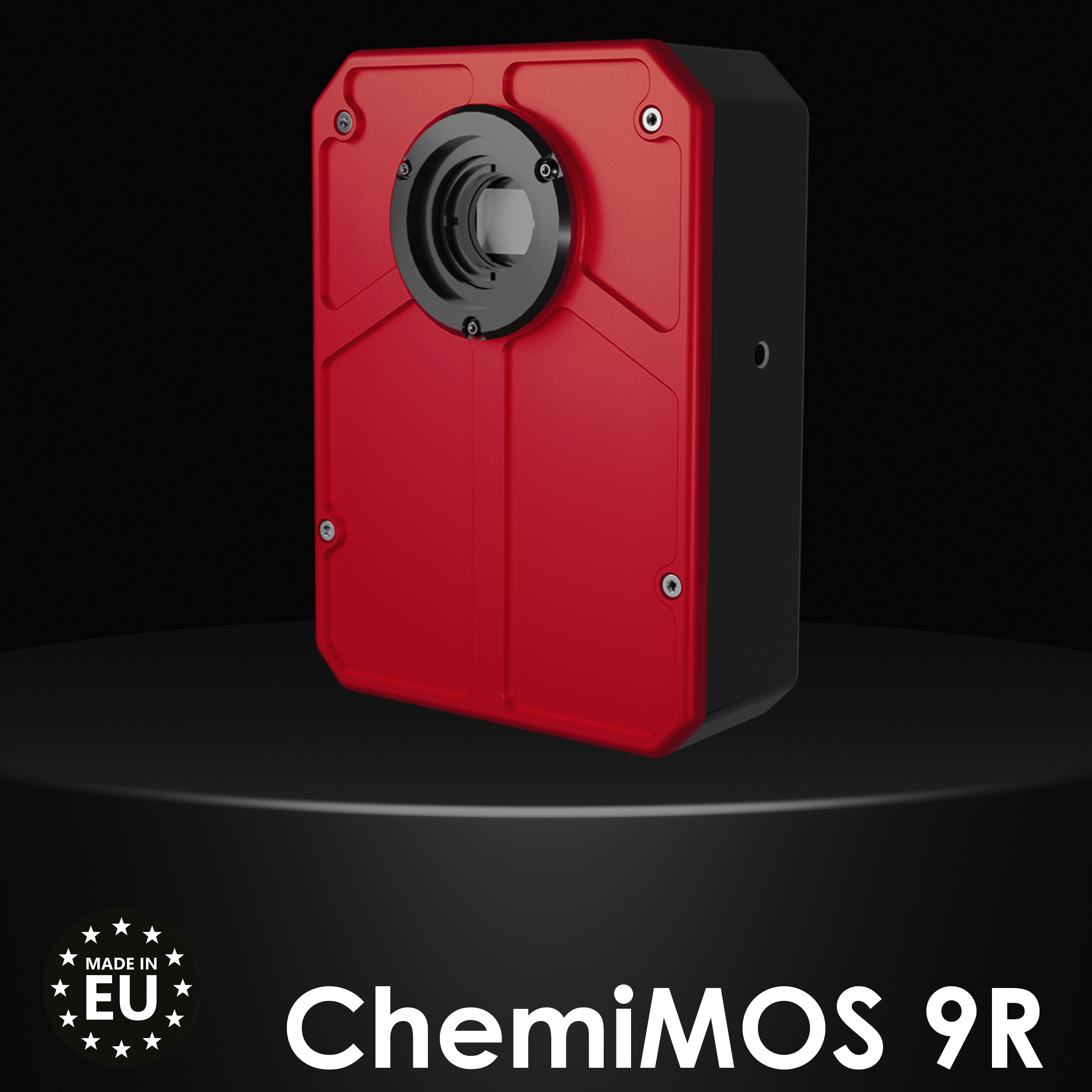So you have done your research, ordered your equipment, set it up, now what? Astrophotography can be a daunting hobby to start with for the beginner. What object do you point your telescope at that you know you can image and you won’t be too frustrated in the process during what is about to be a hugely rewarding learning curve.
I have read ‘newbie’ questioning on forums, astronomy publication recommendations and gained the experts advise at Atik cameras, all in the pursuit of making this incredibly diverse hobby easier to navigate.
There are a number of sky chart apps available for iPhone and Android that will help you get started on pointing in the right direction. Our favourite beginners (the most informative and easy to find information on) is Sky Safari.
Nebulae
M42 [Orion Nebula]
Looking just below Orion’s belt, to the hazy patch surrounding Theta Orionis, the middle star in the Sword of Orion, just south of Orion’s Belt is the very popular Orion Nebula (with in the greater Orion Molecular Cloud Complex). It is in very close proximity to and often photographed with the Running Man Nebula. Orion Nebular is one of the brightest and nearest nebula to earth.
Observed: Winter & Spring
Constellation: Orion
NGC 1977 [The Running Man Nebula]
Is the northernmost part of Orion’s Belt, just left of Orion Nebula is this reflection nebula that resembles a ghost man running through space. It gets its blue hue from the interstellar dust that is reflecting the light from hot young stars in the open cluster NGC 1981.
Observed: Winter & Spring
Constellation: Orion
Horses Head Nebula
Is a dark nebula also in the constellation Orion. It is located just to the south of the star Alnitak. This nebula is most easily identifiable by the luminated silhouette of the cloud of dark gases that resembles the rearing head of a horse.
Observed: Winter & Spring
Constellation: Orion
Plus the Flame Nebula
The bright star Alnitak the last star in Orion’s belt, shines ultraviolet light into the nebula, much of the glow is a result of electrons and ionised hydrogen recombining, with dark gas and dust lying in front of part of the nebula causing the dark network that forms the shape of the flame.
Observed: Winter & Spring
Constellation: Orion
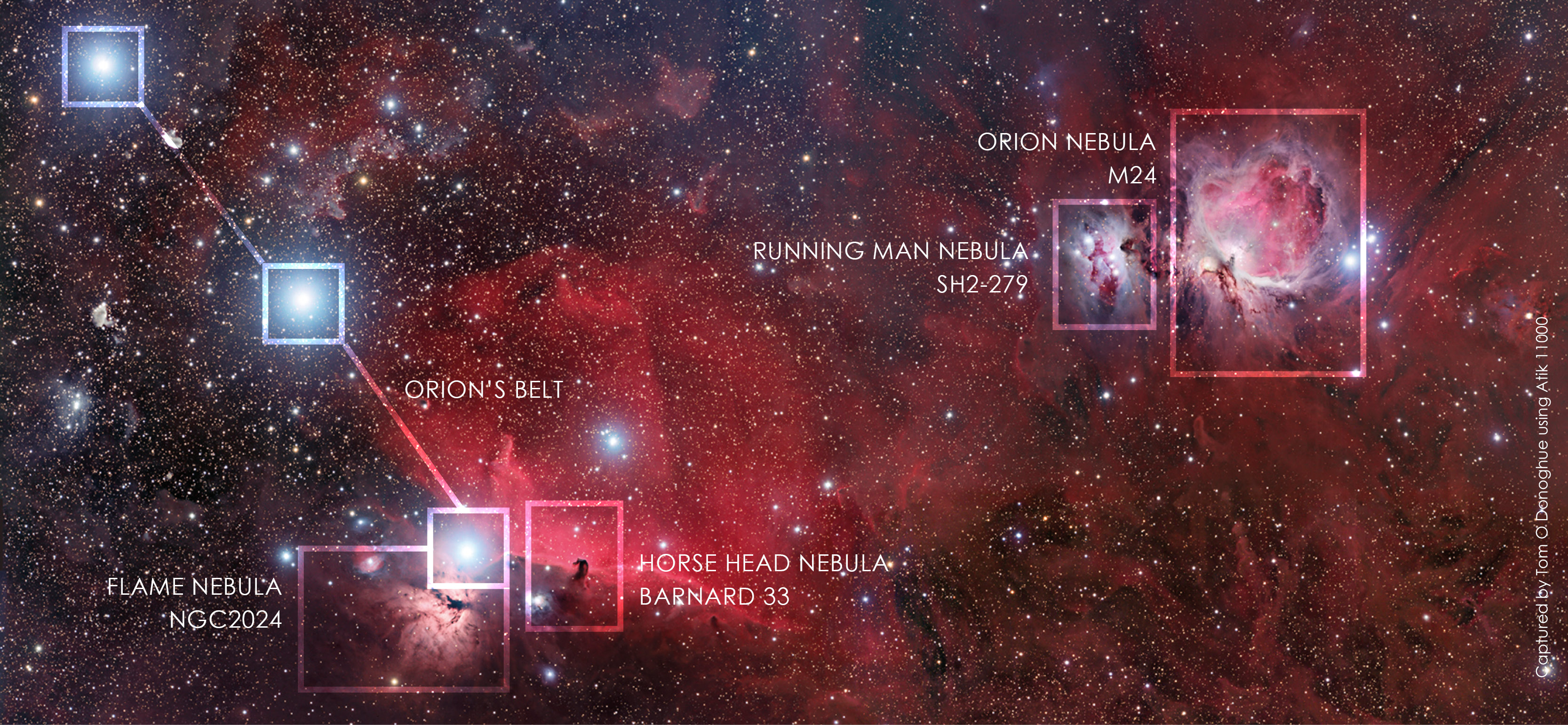
M 27 [Dumbbell Nebula]
This glowing display of vivid colour is the result of an old star that has shed outer layers. M27 is one of the brightest planetary nebula in the sky and is easy to locate and observe. Looking north of Sagitta (the Arrow), start with the star to the right of the tip of the Arrow, gamma Sagittae. Look north from there by about 3 degrees and you’ll find the Dumbbell Nebula.
Observed: Autumn, Winter, Spring
Constellation: Vulpecula, the Fox
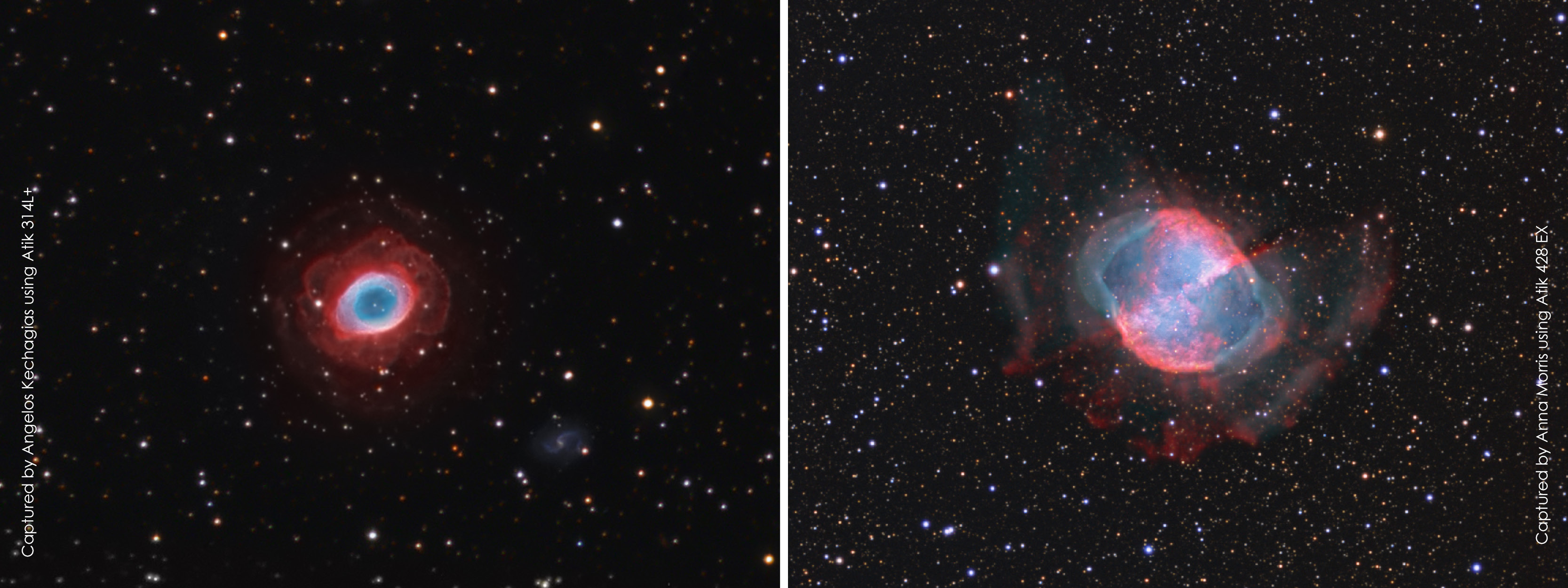
M57 [The Ring Nebula]
Is the glowing remains of a sun like star. The tiny dot in the centre of the nebula is the stars hot core. Planetary nebula are formed when a shell of ionised gas is expelled by a red giant star, which is ending its life span and becoming a white dwarf. Over the next few thousands of years the Nebula will grow until it fades an finally disperses. To locate M57 locate Vega (which is very bright). With the naked eye, just a bit down to the left, you will see 2 stars a little bit apart in a slightly slanted horizontal position (Sulafat and Sheliak). Right, in between those 2 stars is M57.
Observed: August
Constellation: Lyra
Stars, galaxies and clusters
Andromeda Galaxy, M31 – Spiral Galaxy
M31 [Andromeda Galaxy and M110]
This beautiful spiral galaxy is on a collision course with the Milky Way (not for another few billion years. The Andromeda Galaxy has many satellite galaxies orbiting it, of these at least 14 are dwarf galaxies, M110 (the dwarf elliptical galaxy seen in the left image just under the Andromeda Galaxy) is the second biggest, thought to be rather unusual due to its large clouds of gas and dust. When looking through a small telescope it is a faint defuse of light , but with larger telescopes you’ll see the oval shape with a bright core.
Observed: Summer, Fall, Winter
Constellation: Andromeda

M13 [Hercules Cluster]
The great Globular Cluster in Hercules is one of the brightest globular clusters in the northern sky, containing hundreds and thousands of stars with its red and blue giant stars showing up in images as yellow and blue. The clusters look large and bright due to its close proximity to earth at a distance of 25 000 light years away and is located around the “right hip area” of Hercules, centre of the two stars Vega and Arcturus.
Observed: Spring, Summer, Autumn
Constellation: Hercules
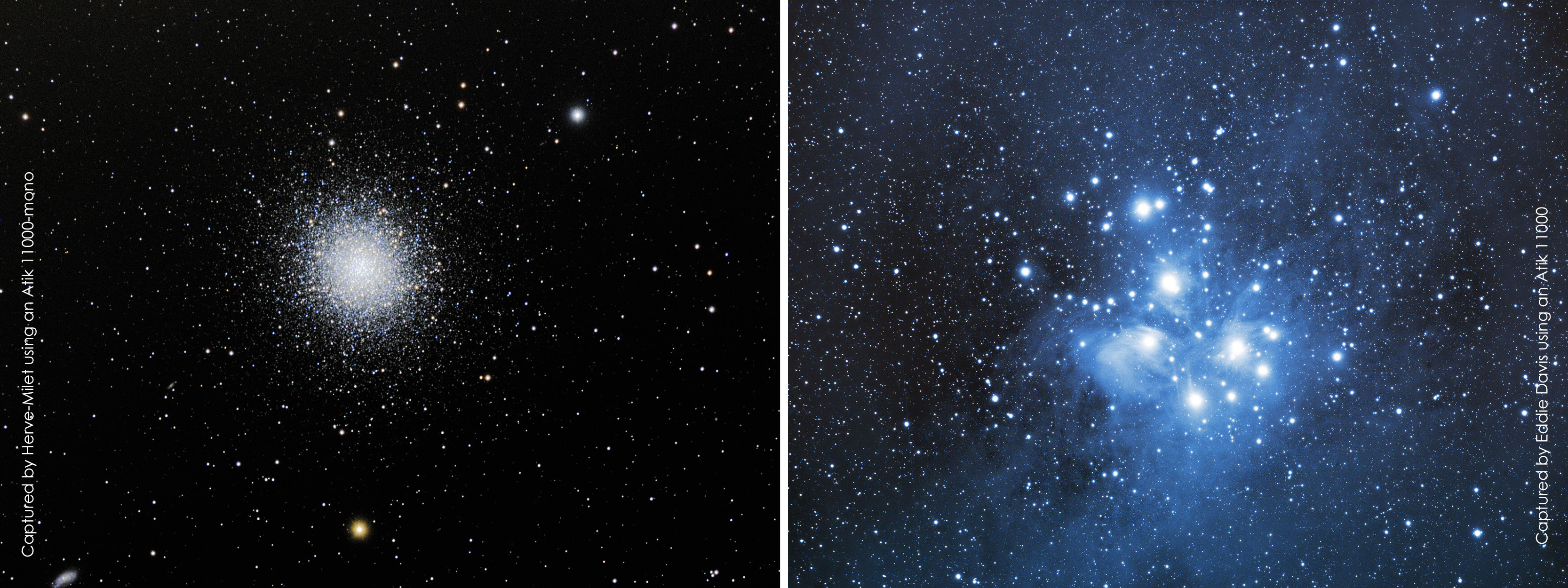
M45 [the Seven Sisters, Pleiades]
The seven sisters of M45 are what is known as an open star containing thousands of stars loosely bound by gravity, but visually dominated by its 7 brightest members. The cluster is visible to the naked eye without a scope and can be a good target for learning how to capture dim nebulae with a camera. It’s also known as the Pleiades, one of the stars in this cluster called Maia luminates a faint reflection nebula surrounding it called the Maia Nebula, as well as the reflection nebula called Merope Nebula, found surrounding the star Merope.
Observed: January
Constellation: Taurus
Albireo [Beautiful Double Star also called Beta Cygni]
Is the 5th brightest star in the constellation Cygnus (the swan into which the god Zeus turned himself to seduce Leba, wife of the King of Sparta). With the naked eye Albireo appears as a single star but viewed through a telescope this double star is striking in its contrasting colours (larger brighter star shines yellow and smaller star shines blue).
Observed: Spring to fall
Constellation: Cygnus
These are just a few of our favourites for the beginner and even those more experienced using our cameras for astrophotography!
Once you start to look you will find huge amounts of valuable information out there. The Atik Cameras CCD Field Calculator app is a great place to help you find which targets are best for you to capture with your set up. Other incredible sources of information on what you will find in the sky right now and where to find it is>
https://www.cloudynights.com/topic/533707-best-of-the-beginners-forum-how-tos/
https://themcdonalds.net/richard/wp/recommended-beginner-astronomy-targets/
Wishing you clear skies and beautiful imaging!

